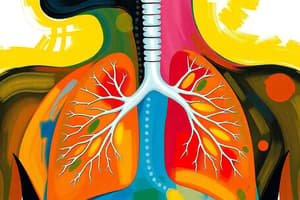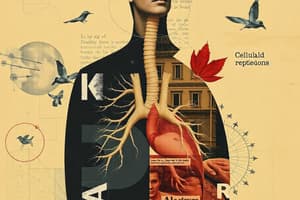Podcast
Questions and Answers
Match the following gases with their primary functions in blood transport:
Match the following gases with their primary functions in blood transport:
Oxygen = Bound to hemoglobin for transport Carbon Dioxide = Combined with water to form bicarbonate ions
Match the following blood components with their descriptions:
Match the following blood components with their descriptions:
Hemoglobin = Protein that carries oxygen in red blood cells Bicarbonate Ions = Main form of CO2 transport in blood Oxygenated Blood = Color is bright cherry-red Deoxygenated Blood = Color is maroon-red
Match the following gas exchange locations with their characteristics:
Match the following gas exchange locations with their characteristics:
Lungs = High O2, Low CO2 Body Cells = Low O2, High CO2 Capillaries = Site of CO2 diffusion from cells Alveoli = Site of gas exchange with blood
Match the mechanisms of CO2 transport in blood with their percentages:
Match the mechanisms of CO2 transport in blood with their percentages:
Match the following substances with their roles in gas exchange:
Match the following substances with their roles in gas exchange:
Match the following concepts with their descriptions related to gas exchange:
Match the following concepts with their descriptions related to gas exchange:
Match the following adaptations to their roles in diffusion of gases:
Match the following adaptations to their roles in diffusion of gases:
Match the parts of the human respiratory system with their functions:
Match the parts of the human respiratory system with their functions:
Match the following gases with their roles in the respiratory process:
Match the following gases with their roles in the respiratory process:
Match the terms with their definitions in the context of respiration:
Match the terms with their definitions in the context of respiration:
Match the respiratory system features with their characteristics:
Match the respiratory system features with their characteristics:
Match the following processes with their relevance to gas exchange:
Match the following processes with their relevance to gas exchange:
Match the following respiratory concepts with their connections:
Match the following respiratory concepts with their connections:
Match the following parts of the respiratory system with their functions:
Match the following parts of the respiratory system with their functions:
Match the following terms related to air conduction with their descriptions:
Match the following terms related to air conduction with their descriptions:
Match the following functions of the epiglottis with their scenarios:
Match the following functions of the epiglottis with their scenarios:
Match the following components with their role in sound production:
Match the following components with their role in sound production:
Match the phases of respiration with their descriptions:
Match the phases of respiration with their descriptions:
Match the following components of the conducting portion of the respiratory system with their characteristics:
Match the following components of the conducting portion of the respiratory system with their characteristics:
Match the following descriptions with the correct respiratory components:
Match the following descriptions with the correct respiratory components:
Match the following components of gas exchange with their descriptions:
Match the following components of gas exchange with their descriptions:
Match the following statements about gas diffusion with their effects:
Match the following statements about gas diffusion with their effects:
Match the following characteristics of alveoli with their functions:
Match the following characteristics of alveoli with their functions:
Match the following processes with their corresponding gas:
Match the following processes with their corresponding gas:
Match the following terms related to lung structure with their definitions:
Match the following terms related to lung structure with their definitions:
Match the following functions of the lungs with their descriptions:
Match the following functions of the lungs with their descriptions:
Match the following facts about the human lungs with their significance:
Match the following facts about the human lungs with their significance:
Match the following types of gases with their exchange processes:
Match the following types of gases with their exchange processes:
Match the following terms with their descriptions related to the respiratory system:
Match the following terms with their descriptions related to the respiratory system:
Match the following components of the respiratory center with their functions:
Match the following components of the respiratory center with their functions:
Match the following respiratory events with their processes:
Match the following respiratory events with their processes:
Match the following functions with their corresponding descriptions:
Match the following functions with their corresponding descriptions:
Match the following statements with their relevance to gas exchange:
Match the following statements with their relevance to gas exchange:
Match the following types of air movement with their characteristics:
Match the following types of air movement with their characteristics:
Match the following anatomical terms with their functions in breathing:
Match the following anatomical terms with their functions in breathing:
Match the following aspects of respiratory mechanics with their implications:
Match the following aspects of respiratory mechanics with their implications:
Flashcards
Alveoli
Alveoli
Tiny air sacs in the lungs where gas exchange occurs.
Gas Exchange
Gas Exchange
The movement of gases between the alveoli and the blood.
Surfactant
Surfactant
A substance that reduces surface tension in the alveoli, preventing them from collapsing.
Respiratory Membrane
Respiratory Membrane
Signup and view all the flashcards
Capillaries
Capillaries
Signup and view all the flashcards
Diffusion
Diffusion
Signup and view all the flashcards
Atelectasis
Atelectasis
Signup and view all the flashcards
Inspiration
Inspiration
Signup and view all the flashcards
Oxygen Transport
Oxygen Transport
Signup and view all the flashcards
Carbon Dioxide Transport
Carbon Dioxide Transport
Signup and view all the flashcards
Oxygen and Carbon Dioxide Exchange
Oxygen and Carbon Dioxide Exchange
Signup and view all the flashcards
Hemoglobin
Hemoglobin
Signup and view all the flashcards
Cellular Respiration
Cellular Respiration
Signup and view all the flashcards
Respiratory system
Respiratory system
Signup and view all the flashcards
Conducting portion of the respiratory system
Conducting portion of the respiratory system
Signup and view all the flashcards
Gas-exchange portion of the respiratory system
Gas-exchange portion of the respiratory system
Signup and view all the flashcards
Moist respiratory surfaces
Moist respiratory surfaces
Signup and view all the flashcards
Thin respiratory surfaces
Thin respiratory surfaces
Signup and view all the flashcards
What is breathing?
What is breathing?
Signup and view all the flashcards
How does inhalation happen?
How does inhalation happen?
Signup and view all the flashcards
What is the role of the diaphragm in inhalation?
What is the role of the diaphragm in inhalation?
Signup and view all the flashcards
How do rib muscles contribute to inhalation?
How do rib muscles contribute to inhalation?
Signup and view all the flashcards
How does exhalation happen?
How does exhalation happen?
Signup and view all the flashcards
What happens to the diaphragm and ribs during exhalation?
What happens to the diaphragm and ribs during exhalation?
Signup and view all the flashcards
What controls breathing rate?
What controls breathing rate?
Signup and view all the flashcards
Why is breathing rate adjusted?
Why is breathing rate adjusted?
Signup and view all the flashcards
Pharynx
Pharynx
Signup and view all the flashcards
Larynx
Larynx
Signup and view all the flashcards
Epiglottis
Epiglottis
Signup and view all the flashcards
How are sounds produced in the larynx?
How are sounds produced in the larynx?
Signup and view all the flashcards
Trachea
Trachea
Signup and view all the flashcards
Bronchi and Bronchioles
Bronchi and Bronchioles
Signup and view all the flashcards
Study Notes
Respiration
- Respiration is the process of exchanging gases with the environment, supporting cellular respiration.
- Gas exchange, in all organisms, relies on diffusion.
- Cellular respiration converts nutrients into ATP, a crucial energy source. This requires a steady supply of oxygen (O2) and produces carbon dioxide (CO2) as a waste product.
- To facilitate diffusion, animals adapt in three main ways:
- Respiratory surfaces stay moist, as gases must dissolve in water to diffuse through cell membranes.
- Surfaces are thin to reduce diffusion distances.
- Surfaces have a larger area to accommodate sufficient gas exchange.
Human Respiratory System
-
The respiratory system is divided into two parts:
- Conducting portion: This system of passageways carries air to/from the gas-exchange portion.
- Gas-exchange portion: The lungs, where oxygen and carbon dioxide exchange with blood.
-
The conducting portion includes:
- Nasal cavity/oral cavity: Entry points for air.
- Pharynx: A chamber behind the nasal/oral cavity.
- Larynx ("voice box"): Houses the vocal cords. The epiglottis guards the larynx opening to prevent food from entering the airway.
- Trachea ("windpipe"): Reinforced cartilage prevents collapsing, splits into bronchi.
- Bronchi: Lead into the lungs.
- Bronchioles: Smaller branches leading from the bronchi.
- Alveoli: The tiny air sacs where gas exchange occurs (clustered at the end of bronchioles).
-
Breathing:
- Inhalation:
- The diaphragm contracts, pulling downward.
- Rib muscles contract, lifting ribs up.
- Chest cavity expands, creating a lower pressure gradient. Air rushes in.
- Exhalation:
- Diaphragm relaxes, moving upward.
- Rib muscles relax, causing rib movement downward.
- Chest cavity decreases in size, creating a higher pressure gradient. Air rushes out.
- Inhalation:
-
Breathing control (by the respiratory center in the brain):
- The center receives input (e.g., CO2 levels) to adjust the breathing rate/volume.
- CO2 receptors in the medulla monitor CO2 concentration in the blood to finely regulate respiration rate.
Gas Exchange in the Alveoli
-
Gas exchange occurs in the alveoli.
-
The alveoli provide a large surface area and contain a thin layer of fluid with surfactant (preventing sticking and collapse).
-
Alveolar walls have a single epithelial cell layer allowing diffusion of gases across a thin respiratory membrane to capillaries.
-
Oxygen transport in the blood:
- Most (98%) oxygen binds to hemoglobin in red blood cells.
- Hemoglobin's shape changes when O2 binds, altering blood color (bright red).
-
Carbon dioxide transport in the blood:
- CO2 is transported in three ways: dissolved in plasma, bound to hemoglobin, and converted to bicarbonate ions.
- Bicarbonate ions are transported in plasma.
-
Gas exchange in the alveoli is driven by concentration gradients.
Studying That Suits You
Use AI to generate personalized quizzes and flashcards to suit your learning preferences.




